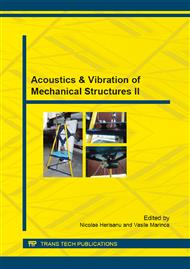[1]
T. Zielińska, Biological inspiration used for robots motion synthesis, J. Phisiol. 103 (2009) 133-140.
Google Scholar
[2]
T. Zielińska, C.M. Chew, P. Kryczka, T. Jargilo, Robot gait synthesis using the scheme of human motion skills development, Mech. Mach. Theory 44(3) (2009) 541-558.
DOI: 10.1016/j.mechmachtheory.2008.09.007
Google Scholar
[3]
W. Chen, G. Ren, J. Zhang, J. Wang, Smooth transition between different gaits of a hexapod robot via a central pattern generators algorithm, J. Intell. Robot. Syst. 67 (2012) 255-270.
DOI: 10.1007/s10846-012-9661-1
Google Scholar
[4]
B. Jin, C. Chen, W. Li, Power consumption optimization for a hexapod walking robot, J. Intell. Robot. Syst. 71 (2013) 195-209.
DOI: 10.1007/s10846-012-9771-9
Google Scholar
[5]
R. Altendorfer, N. Moore, H. Komsuoglu, M. Buehler, H.B. Brown jn., D. McMordie, U. Saranli, R. Full, D.E. Koditschek, Hex: a biologically inspired hexapod runner, Auton. Robot. 11 (2001) 207-213.
DOI: 10.1023/a:1012426720699
Google Scholar
[6]
M.S. Erden, Optimal protraction of a biologically inspired robot leg, J. Intell. Robot. Syst. 64(3, 4) (2011) 301-322.
DOI: 10.1007/s10846-011-9538-8
Google Scholar
[7]
J. Nishii, Legged insects select the optimal locomotor pattern based on the energetic cost, Biol. Cybern. 83 (2000) 435-442.
DOI: 10.1007/s004220000175
Google Scholar
[8]
J. Nishii, An analytical estimation of the energy cost for legged locomotion, J. Theor. Biol. 238 (2006) 636-645.
DOI: 10.1016/j.jtbi.2005.06.027
Google Scholar
[9]
T.A. Guardabrazo, P. Gonzalez de Santos, Building an energetic model to evaluate and optimize power consumption in walking robots, Ind. Robot. 31(11) (2004) 201-208.
DOI: 10.1108/01439910410522874
Google Scholar
[10]
P. Gonzalez de Santos, E. Garcia, R. Ponticelli, M. Armada, Minimizing energy consumption in hexapod robots, Adv. Robot. 23 (2009) 681-704.
DOI: 10.1163/156855309x431677
Google Scholar
[11]
E. Garcia, J.A. Galvez, P. Gonzalez de Santos, On finding the relevant dynamics for model-based controlling walking robots, J. Intell. Robot. Syst. 37 (2003) 375-398.
Google Scholar
[12]
P. Gonzalez de Santos, J. Estremera, E. Garcia, Optimizing leg distribution around the body in walking robots, in: Proceedings of the 2005 IEEE International Conference on Robotics and Automation, Barcelona, Spain, (2005).
DOI: 10.1109/robot.2005.1570604
Google Scholar
[13]
V. Durr, J. Schmitz, H. Cruse, Behaviour-based modelling of hexapod locomotion: linking biology and technical application, Arthropod Struct. Dev. 33(3) (2004) 237-250.
DOI: 10.1016/j.asd.2004.05.004
Google Scholar
[14]
M. Schilling, T. Hoinville, J. Schmitz, H. Cruse, Walknet, a bio-inspired controller for hexapod walking, Biol. Cybern. 107 (2013) 397-419.
DOI: 10.1007/s00422-013-0563-5
Google Scholar
[15]
J. Zhao, H. Zhang, Y.B. Liu, J.H. Yan, X.Z. Zang, Z.W. Zhou, Development of the hexapod robot HITCR-II for walking on unstructured terrain, in: Proceedings of 2012 IEEE International Conference on Mechatronics and Automation, Chengdu, China, 2012, 64-69.
DOI: 10.1109/icma.2012.6282808
Google Scholar
[16]
A. Cohen, P. Holmes, R. Rand, The nature of the coupling between segmental oscillators of the lamprey spinal generator or locomotion: a mathematic model, J. Math. Biol. 13 (1982) 345-369.
DOI: 10.1007/bf00276069
Google Scholar
[17]
M. Piątek, Robot's control problems - central pattern generators, Doctoral thesis - supervisor Andrzej Turnau, University of Mining and Metallurgy, Krakow, Poland, 2012, 163 pages (in Polish).
Google Scholar
[18]
A. Ijspeert, Central pattern generators for locomotion control in animals and robots: a review, Neural Netw. 21(4) (2008) 642-653.
DOI: 10.1016/j.neunet.2008.03.014
Google Scholar
[19]
S. Steingrube, M. Timme, F. Wörgötter, P. Manoonpong, Self-organized adaptation of a simple neural circuit enables complex robot behaviour, Nat. Phys. 6 (2010) 224-230.
DOI: 10.1038/nphys1508
Google Scholar


